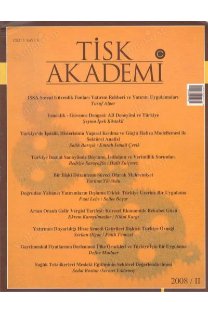OECD ülkelerinde rekabet gücünün nedensellik ilişkisi: Ampirik bir analiz
Çalışmada dış ticaret ve rekabet gücü teorisyenlerinin ileri sürdüğü ulusal rekabet gücünü belirleyici bazı faktörler ile OECD Sekreteryası tarafından yayınlanan ulusal rekabet gücü göstergesi arasındaki nedensellik ilişkisinin yönünü tahmin etmek maksadıyla analiz için yeterli verileri temin edilebilen her bir OECD ülkesi için Granger Nedensellik Testleri uygulanmış ve bu testlerin sonuçları değerlendirilmiştir. Bahse konu testler neticesinde analize konu olan çoğu faktörün OECD ülkelerinde genel olarak rekabet gücüne neden olduğu tespit edilmesine karşın bazı parametreler için teorik beklentilerin aksini gösteren sonuçların ortaya çıktığı görülmüştür. Bu şekilde tezat bir ilişkinin mevcudiyetinin ulusal rekabet gücünün tüketici fiyatlarına dayalı reel efektif döviz kuru gibi kısıtlı bir göstergeye indirgenemeyecek kadar karmaşık bir kavram olması ndan kaynaklandığı değerlendirilmiştir. JEL Sınıflaması: C22, D24, O50
Empirical analysis of causality relationships between national competitiveness and factors determining competitiveness in OECD countries
In this study, Granger Causality Tests are applied to estimate the direction of the causality relationships between the national competitiveness indicator published by OECD Secretary and some theoretical factors claimed to have been determining the national competitiveness for each OECD country which has enough data to be analyzed and then results of these tests are interpreted. As a result of these tests, it is found that many factors mentioned before generally cause the national competitiveness but some of the parameters have results contrary to the theoretical expectations in OECD countries. National competitiveness is such a complicated concept that it can not be reduced to a limited indicator like a real effective exchange rate based on the consumer prices, so it is thought that the reason of these contrasting results is due to this fact. JEL Classification: C22, D24, O50
___
- Aiginger, K. (2006). Competitiveness: From a Dangerous Obsession to a Welfare Creating Ability with Positive Externaties. J Int Compet Trade. 6, 161-177.
- Akal, M. (2006). Causalities Among Growth Related Policy Variables in Turkey, 1950-2004. Applied Econometrics and International Development. 6(3), 75-104.
- Aktan, C. C. ve Vural, İ. Y. (2004). Rekabet Gücü ve Rekabet Stratejileri. Rekabet Dizisi 2. Ankara: TİSK.
- Appleyard, D. R. ve Field, A.J. (1995). International Economics.USA.
- Charbaugh, R. J. (2005). International Economics, Tenth Edition. South-Western, USA: Thomson.
- Davies, H. ve Ellis, P. (2000). Porter’s Competitive Advantage Of Nations: Time For The Final Judgement? Journal of Management Studies. 37(8), 1189-1213.
- Düzgün, R. (2007). Türkiye’nin Uluslararası Rekabet Gücü: Çok Değişkenli İstatiksel Bir Analiz. Erciyes Üniversitesi Sosyal Bilimler Enstitüsü Dergisi. 23, 421-440.
- Durand, M., Simon J. ve Webb, J. (1992). OECD’s Indicators of International Trade and Competitiveness. OECD Economics Department Working Papers. No.120.
- Durand, M., Madaschi C. ve Terribile, F. (1998). Trends in OECD Countries’ International Competitiveness: The Inşuence of Emerging Market Economies. OECD Economics Department Working Papers. No.195.
- Granger, C.W.J. (1969). Investigating Casual Relations by Econometric Models and Cross-spectral Methods. Econometrica. 37(3),424-438.
- Grilo, I. ve Koopman, G.J. (2006). Productivity and Microeconomic Reforms: Strengthening EU Competitiveness. Journal of Industry, Competition and Trade, Special Issue on Competitiveness. 6(2), 67–84.
- Grossman, G.M. ve Helpman, E. (1989). Quality Ladder and Product Cycles. NBER Working Paper Series. No.3201. Cambridge.
- IMF Veri Tabanı, 15 Ocak 2011 tarihinde http://www.imfstatistics.org/imf adresinden erişildi.
- Karluk, R. (2002). Uluslararası Ekonomi Teori ve Politika. İstanbul:Beta Basım Yayı m Dağıtım A.Ş.
- Ketels, C.H.M. (2006). Michael Porter’s Competitiveness Framework- Recent Learnings and New Research Priorities. J Ind Compet Trade. 6, 115-136.
- Kibritçioğlu, A. (1996). Uluslararası Rekabet Gücüne Kavramsal Bir Yaklaşım 19 Eylül 2009 tarihinde http://129.3.20.41/ eps/it/papers/0509/0509008.pdf adresinden erişildi.
- Krugman, P. R. ve Obstfeld, M. (2009). International Economics Theory and Policy. Eight Edition. Boston: Pearson.
- Krugman, P. R. (1994). Competitiveness: A Dangerous Obsession. Foreign Affairs. 23(2), 28-44.
- Krugman, P. R.(1980). Scale Economies, Product Differentiation and the Pattern of Trade. The American Economic Review. 70(5), 950-959.
- Krugman, P. R.(1979a). A Model of Innovation, Technology Transfer, and the World Distrubition of Income.The Journal of Economy. 87(2), 253-266.
- Krugman, P. R.(1979b). Increasing Returns, Monopolistic Competition and International Trade. Journal of International Economics. 9, 469-479.
- KTO (Konya Ticaret Odası). (2008). Yunanistan Ülke Raporu. 8 Nisan 2011 tarihinde http://www.setav.org/ups/dosya/19587.pdf adresinden erişildi.
- Lai, E.L.C. (1995). The Product Cycle and the World Distrubition of Income. A reformulation. Journal of International Economics. 39, 369-382.
- Markusen, J. R., Melvin, J.R., Kaempfer, W.H. ve Maskus, K.E. (1995). International Trade, Theory and Evidence. USA: McGraw-Hil.
- OECD (2008). Glossary of Statistical Terms. 25 Nisan 2011 tarihinde http://stats. oecd.org/glossary/glossaryPDF.zip adresinden erişildi.
- OECD Veritabanı 15 Nisan 2011 tarihinde http://stats.oecd.org adresinden erişildi. Porter, M.E. (2002). Enhancing the Microeconomic Foundations of Prosperity: The Current Competitiveness Index 30 Kasım 2009 tarihinde http://www.isc.hbs.edu/ Micro_9201 adresinden erişildi.
- OECD (1998). Clusters and the New Economics of Competition. Harward Business Reviev. November-December, 77-90.
- OECD (1990). The Competitive Advantage of Nations. China: MacMillan.
- Salvatore, D. (1990). Theory and Problems of International Economics. Third Edition. USA: McGraw-Hill.
- Seyidoğlu, H. (2007). Uluslararası İktisat (Onaltıncı Baskı). İstanbul: Güzem Can Yayınları.
- Siggel, E. (2007). International Competitiveness and Comparative Advantage: A Survery and a Proposal for Measurement 9 Kasım 2010 tarihinde http://www.ifo.de/ link/vsi07_mdc_degrauwe_Siggel_p2.pdf adresinde erişildi.
- World Bank Veritabanı 13 Şubat 2011 tarihinde http://databank.worldbank.org, adresinde erişildi.
- Yetton, P., Craig, J., Davis, J., ve Hilmer, F. (1992). Are Diamonds a Country’s Best Friend? A Critique of Porter’s Theory of National Competition as Applied to Canada, New Zeland and Australia. Australian Journal of Management. 17(1), 89-119.
- ISSN: 1306-6757
- Yayın Aralığı: Yılda 2 Sayı
- Başlangıç: 2006
- Yayıncı: Türkiye Isveren Sendikalari Konfederasyonu
Sayıdaki Diğer Makaleler
İklim değişiminin sosyal politika açısından değerlendirilmesi
Hüseyin TATLIDİL, Barış ÖZGÜRLÜK
Demokrasi ve dış ticaret: OECD ve MENA ülkeleri örneği
CEMALETTİN KALAYCI, Seyfettin ADTAN
OECD ülkelerinde rekabet gücünün nedensellik ilişkisi: Ampirik bir analiz
Mustafa AKAL, Seyit Muharrem GÖKMENOĞLU
Türkiye’de ara eleman ihtiyacına yönelik tespitler ve karşılaşılan sorunlar üzerine bir araştırma
Para politikası ve ücret pazarlıkçıları arasındaki stratejik etkileşim
Mali kural ve etkinlik sorunu: Türkiye örneği
Nevzat SAYGILIOĞLU, Ali Çelen ERDURAN
Önceye etkili toplu iş sözleşmesinde üyelik aidatının işverence kesilmesi
